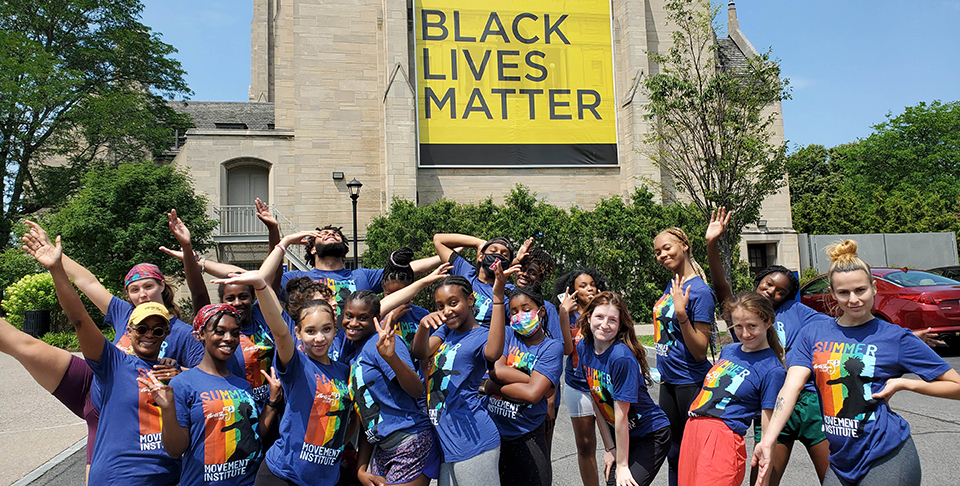Representation matters.
The Memorial Art Gallery is an arts organization that acquires, cares for, and exhibits art. Through art, we tell stories that reflect, challenge, and celebrate life and cultures. As such, we are inexorably linked to the events that surround us. #BlackLivesMatter
For MAG, the declaration that “Representation Matters” is a reminder of the key objectives of our work: who are the artists represented in our galleries, and what images are represented in their art? Who represents MAG on our staff, among our Docents, and on our Board leadership? Who represents our audience? Are we fairly reflecting the people and communities who represent our city, our region, our nation, our world?*
MAG will be sharing with you how we’re doing in all of these regards, how we are meeting, or not, the objective to fairly reflect the people we serve.
*The Memorial Art Gallery is a part of the University of Rochester and is the civic art museum for the region. For information on Rochester demographics, please see the Rochester page of Census Reporter.
At the start of 2021, MAG issued its first staff Diversity, Equity, Accessibility, and Inclusion (DEAI) survey. The results of the survey appear here. This survey will be issued periodically to track MAG’s progress as we strive to better and more fairly reflect the region in which we live and work and that we serve.
To see a list of MAG’s senior team CLICK HERE
MAG is a part of the University of Rochester. To view the University of Rochester’s Staff Diversity Dashboard CLICK HERE
To see the race and ethnicity demographics of the Rochester Metro Area, CLICK HERE
Race/Ethnicity
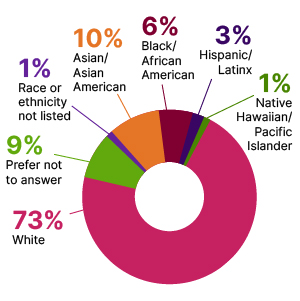
Gender
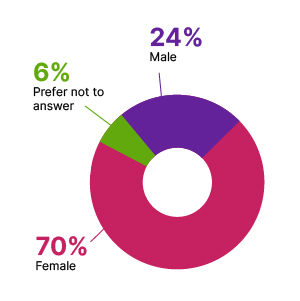
LGBTQ+
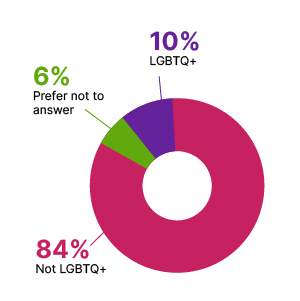
ADA Limitations
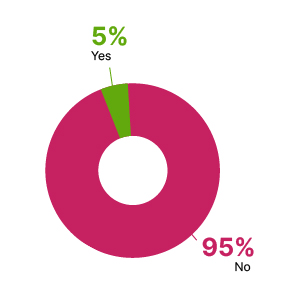
At the start of 2021, MAG issued its first Board Diversity, Equity, Accessibility, and Inclusion (DEAI) survey. The results of how the Board self-identifies appear here. This survey will be issued periodically to track MAG’s progress as we strive to better and more fairly reflect the region in which we live and work and that we serve.
To see a list of MAG’s Board of Managers, CLICK HERE
To see the race and ethnicity demographics of the Rochester Metro Area, CLICK HERE.
Race/Ethnicity
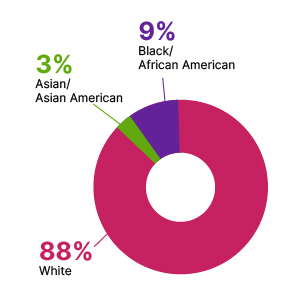
Gender
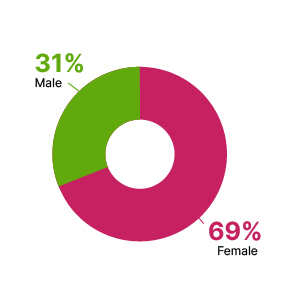
LGBTQ+
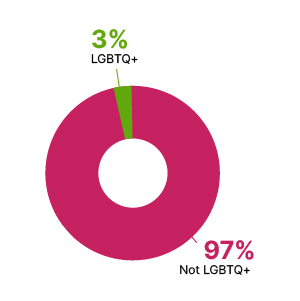
ADA Limitations
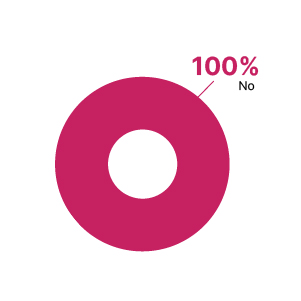
The Memorial Art Gallery was founded on June 26, 1912, and as a gift from Emily Sibley Watson to the University of Rochester (UR) to be maintained for the “benefit of the University and of the citizens of the City of Rochester.” The entire management and administration of MAG were committed to a Board of Managers, originally comprising 21 people, nine of whom were women, a notable fact at a time when art museum boards and trustees rarely included women. All members were white and of European descent.
The composition of the MAG Board has changed and grown over the years. Today, the Board may include from 25 to 40 volunteer members, all elected to their positions for a three-year term by the Board itself and with the input of MAG’s Director, who is an ex officio member of the Board. Other ex officio members are representatives of the UR community, including the Chair of the UR Board of Trustees, President of UR, Provost of UR or another senior-level academic UR officer of the Provost’s choosing, Senior Vice President for Administration and Finance of UR (MAG’s Treasurer), Dean of the College of Arts and Sciences of UR, Chair of the Department of Art and Art History of UR, and the heads of MAG’s Councils, including the Gallery Council and Docents. All of these individuals are members of MAG’s Board by virtue of their appointments and for so long as they hold such offices.
According to MAG’s bylaws, “the Board shall have the custody, control, and direction of the Gallery, its pictures, works of art, collections and other contents…and it may acquire, by the use of monies which may be at its disposal or by the acceptance of gifts or otherwise, such pictures, works of art and collections as it may deem proper.” Furthermore, “the Board shall assume the responsibility of raising and providing the monies necessary for the current expenses of the Gallery, the carrying on of its work and the acquisitions of additions to its collections, and shall be vested with the authority necessary to that end.” Finally, “the Board shall have the sole right to determine the uses to which the Gallery and its collections shall be put and the right of access and use by the public.” [All quotations here are selected from MAG’s bylaws, updated and revised June 2018.]
THE RECENT PAST TO THE PRESENT
In September 2014 (fiscal year 2015), the elected members of the Board of Managers comprised 36 people. Eighteen of these elected Managers were women.
Diversifying MAG’s Board has indeed been a priority for at least the last six years. As of July 1, 2020 (fiscal year 2021), the elected Board had grown to 37 members, including 24 women and six people of color. MAG’s current Board president, Dr. Marilynn Patterson Grant, is African American.
An example of a project that was instrumental in helping to diversify MAG’s volunteer leadership was Inspiring Beauty: 50 Years of Ebony Fashion Fair, an exhibition organized by the Chicago History Museum. Inspiring Beauty was greatly supported by partnerships with local African American organizations, specifically the Rochester chapter of The Links, Inc., and the Theta Alpha Zeta chapter in Rochester of Zeta Phi Beta Sorority, Inc. Members of these organizations, including MAG’s current Board president, first engaged with MAG on the occasion of this exhibition, generously helping to organize events, programs, and to support and be an ambassador for the overall project. MAG and the community it serves continue to benefit and grow from the relationships established around Inspiring Beauty and other programmatic efforts.
Acquisitions
The following data shows acquisitions made only through purchase over seven fiscal years, from July 1, 2014 to June 30, 2021. Gifts and bequests of art are not represented. Identifying gender, race, and ethnicity for all artists has been done when known, to the best of the museum’s knowledge.
Races and ethnicities included under “Artists of Color”: American Indian/Alaskan Native, Black/African American, Asian, Hispanic, and Middle Eastern.
Number of Acquisitions by Artists of Color
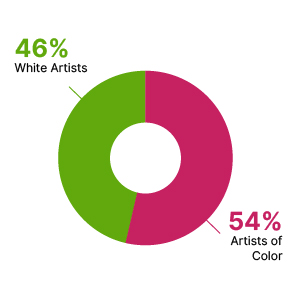
Percentage of Total Funds Spent on Acquisitions by Artists of Color
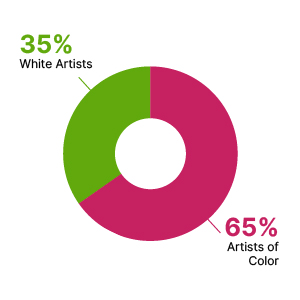
Number of Acquisitions by Gender
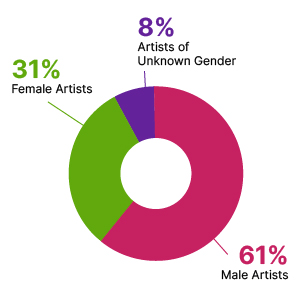
Percentage of Total Funds Spent on Acquisitions by Gender
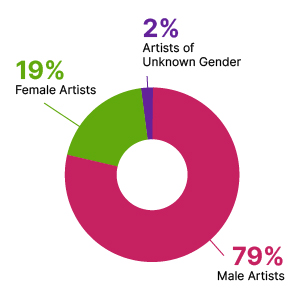
A Report on the Permanent Collection (October 2021)
This report reflects upon the MAG’s permanent collection, including its historical development and future direction. It is intended to assist in building a framework for some of the museum’s key collecting and interpretation priorities as established by our strategic plan, specifically strategic initiatives one and two, which may be viewed HERE [PDF].
In order to advance MAG’s strategic plan, we must:
- Acknowledge and make transparent the historical and structural inequities inherent in the Western museum as an institution founded in colonial, white, Eurocentric, and patriarchal systems.
- Develop a shared understanding between MAG staff, Board, and stakeholders for the responsible collecting, cataloging, interpretation, and installation of MAG’s cultural collections of Indigenous art of the Americas, Africa, and Oceania in the context of ongoing efforts to consider the impact of colonialism and its legacies of violence and displacement implicit within museum collections.
- Develop an intersectional approach to the collection and related installations, exhibitions, and scholarship that embodies a shared commitment to the diverse communities of our region and city. Acquisitions, installations, and exhibitions should be inclusive and reflective of Indigenous, Black, and Latinx artists; reflect a diversity of gender identity, ethnicity, age, and socioeconomic status; and encompass a non-hierarchical approach to the outdated but seemingly entrenched art-craft divide.
THE PAST
For over 100 years, MAG staff and board have worked to create a so-called encyclopedic collection, as founder Emily Sibley Watson established in 1913, “for the edification and enjoyment of the citizens of Rochester.” The museum’s collections of European and American art are the most robust, with the second floor mainly dedicated to European art, and the first floor mainly to American art.
A BRIEF OVERVIEW OF THE SECOND-FLOOR GALLERIES
(ORIGINAL 1913 BUILDING AND 1927 ADDITION)
In a traditional art historical model, MAG’s second-floor galleries begin with an ancient gallery that showcases Greek, Etruscan, Roman, and Egyptian works, highlighted with a set of painted Egyptian coffins that occupy the center of the gallery. The adjacent medieval gallery includes textiles, sculpture, painting, and metalwork from early European Christendom. Newly conserved tapestries are among the highlights of the Renaissance Gallery, and the adjacent Fountain Court features Baroque paintings and sculpture, including works by Anthony van Dyck, El Greco, and Luca Giordano. The 17th-century gallery showcases Old Master painting and decorative arts from The Netherlands and Flanders; many come from the private collection of Kodak founder George Eastman. The 18th-century collection is strong in British, French, and Swiss portraiture including works by Thomas Gainsborough, Hyacinthe Rigaud, and Angelica Kauffmann, while the 19th- and early 20th-century gallery features work from the Barbizon and Hague schools. In the adjacent 19th-century gallery are masterpieces by modern painters such as Paul Cezanne, Claude Monet, and Edouard Vuillard. The nearby Asian Art gallery showcases the museum’s representative collection of paintings, sculpture, and applied arts of the multiple eras and cultures of East and South Asia. A few steps away, the At the Crossroads gallery brings together a small group of works from the ancient Middle East and the Islamic world. This gallery, installed in 2008, incorporated Islamic works of art into the permanent collection display for the first time. Select works, including a Quran and an Islamic calligraphic architectural frieze from India, were acquired to better contextualize this initiative.
A BRIEF OVERVIEW OF THE FIRST-FLOOR GALLERIES (1960s AND 1980s BUILDING ADDITIONS)
The first-floor galleries begin with the American collection from the colonial period, progressing through the 19th century and into the present day. Highlights of the collection include 19th and 20th century masterpieces of American landscape and realist painting, with paintings by Asher B. Durand, Winslow Homer, and Lilly Martin Spencer; early 20th-century works of realism and modernism, including masterpieces by Thomas Hart Benton, Elizabeth Catlett, Stuart Davis, Jacob Lawrence, Georgia O’Keeffe, and John Sloan; a major collection of sculptures by Gaston Lachaise; and late-20th century masterworks by Josef Albers, Helen Frankenthaler, Hans Hofmann, Isamu Noguchi, and Jackson Pollock. MAG’s folk and applied arts include early Rochester-area portraits by itinerant artists, vernacular sculpture, trade signs and weathervanes, as well as a Grandma Moses landscape. Works of contemporary craft art are exhibited in cases nearby.
The current Arts of Africa, Oceania, and the Americas gallery brings together cultural objects created for both ceremonial and everyday use, including a major work by Yoruba sculptor Olowe of Ise. A unique set of problems with this gallery is at the heart of MAG’s current collection planning; it is addressed in greater detail below in 2020–2025 IN FOCUS: PROBLEMS IN MAG’S CULTURAL COLLECTIONS OF INDIGENOUS ART OF THE AMERICAS, AFRICA, AND OCEANIA.
WORKING TO REDRESS THE IMBALANCES
Like most museums founded in the 19th and early 20th centuries throughout the U.S., MAG’s collections placed the arts of Europe and upper-class America at the forefront. A product of their time, these collections were to a great extent shaped by the historical inequities created by systemic colonialism, racism, and sexism. One result is the omission or marginalization of BIPOC (Black, Indigenous, People of Color), women, and LGBTQ+ (Lesbian, Gay, Bisexual, Transgender, Queer/Questioning) artists.
2015–2020 IN FOCUS: IMPROVEMENTS IN CONTEMPORARY ART
The efforts made by MAG staff in recent decades to better balance the collection with women artists, BIPOC artists, and LGBTQ+ artists took on even greater urgency in 2015. That year, MAG’s strategic plan established the collections-specific objectives to strengthen the museum’s contemporary holdings and to build, balance, and interpret the collection to reflect the museum’s diverse and expanding audience as reflected in the Rochester community. Acquisitions during this period were intended not only to enhance the diversity of artists represented by race, but also by gender identity, ethnicity, age, and socioeconomic status. The contemporary galleries on the first floor feature a number of these recent acquisitions. An additional contemporary collecting focus extended historical and aesthetic narratives already present in the collection. This initiative continues to be advanced by juxtaposing contemporary work with historical material in our permanent collection galleries.
Artists whose work was acquired from 2015–2020 include Nick Cave, George Condo, Beauford Delaney, Monir Farmanfarmaian, Sam Gilliam, Hung Liu, Nam June Paik, Grayson Perry, Judith Schaechter, and Mickalene Thomas. The Media Arts Watch initiative to jumpstart and develop the museum’s collection of media art added examples by Charles Atlas, Ja’Tovia Gary, Kalup Linzy, Bruce Nauman, Nam June Paik, Sondra Perry, and Bill Viola. The MAW initiative importantly also showcased two major commissions by Javier Téllez and Isaac Julien.
LOOKING FORWARD
To become an arts institution that fairly represents our community, MAG must move from the traditional model of an “encyclopedic collection” to a 21st-century global universal museum. We must excavate and expose the structural biases that have defined the way we have collected and displayed (or failed to collect and display) the work of various people and cultures for much of our history. This includes rethinking the outdated hierarchy of what is referred to as fine art (sculpture and painting) and applied art (decorative arts and craft) in the art historical model. MAG must expose, acknowledge, and address these biases, clearly manifest in the makeup of the permanent collection of more than 13,000 objects.
MAG’s last strategic plan (2015–2020) identified the need to build, balance, and interpret MAG’s collection to reflect our diverse and expanding audience. According to the present strategic plan (2021–2025), the museum continues to assess the strengths and weaknesses of the permanent collection, and to consider the areas in which it can improve its approach to collecting, displaying, and interpreting art. Only by establishing this as an institutional priority, with the requisite dedicated financial and human resources, will the museum make significant progress in this endeavor.
2021–2025 IN FOCUS: PROBLEMS IN MAG’S CULTURAL COLLECTIONS OF INDIGENOUS ART OF THE AMERICAS, AFRICA, AND OCEANIA
For much of MAG’s history, the collections of Indigenous art of the Americas, Africa, and Oceania were considered “ethnographic” or “tribal” in nature, with these collections displayed together in the same gallery since the late 1980s. As is true for many museums, grouping the art of Africa, Oceania, Ancient America, and Native America together frames these cultures through an anthropological “tribal” lens rather than the aesthetic one applied to the arts of the Western canon. This grouping of objects from disparate cultures across the globe—a museological tradition both artificial and problematic—is a consequence of the colonialist and Eurocentric ideas threaded throughout the Western art historical framework. In addition, at MAG these collections are “othered” by methods of display, interpretation, as well as their placement in the museum in a single, side gallery on the first floor adjacent to the American galleries.
Of the 149 objects on view in MAG’s Arts of Africa, Oceania, and the Americas gallery (or AOA gallery), 61 were gifted to the museum and 88 were purchased, mainly between the 1940s and 1970s. This collecting effort in the mid-20th century was made with the goal of building an encyclopedic collection from which the history of art and artistic civilizations could be taught. What has resulted are limited and fairly static collections that retain the assumptions, limitations, and omissions of the traditional Western art historical model. The classification of objects as utilitarian because they are used in either ritual practices or in everyday life has historically detracted from their significance as artworks that develop out of robust and powerful artistic traditions. There are ways to discuss the ritual use of these objects that also link them to broader artistic traditions and movements, placing them in wider visual arts contexts.
The static quality of the collections of Indigenous art of the Americas, Africa, and Oceania creates a false sense of stalled cultures, presenting a seeming disunity between Indigenous people and modernity. This is further reinforced by MAG’s expansive American and European collections, which have grown over the years owing to dedicated curatorial expertise and financial resources. MAG is committed to interrogating and addressing these issues and prioritizing solutions. A dedication of staff and financial resources, more robust contextualization, repatriation efforts, putting historical objects in conversation with each other in new ways and with contemporary artworks, as well as rethinking the placement of objects within the museum, can better represent the artworks and the cultures in which they were created.
The Memorial Art Gallery’s approach to public programs begins with the belief that any individual should be able and empowered to engage with our collection and exhibitions in meaningful ways. We strive to present opportunities for everyone in this region to see MAG as a part of their own community and as a place where they feel a genuine sense of belonging. Two key departments are primarily responsible for shaping and facilitating MAG’s public engagement opportunities.
Academic Programs Department
The Academic Programs Department designs and facilitates programs, such as the Expanded Learning Collaboration (ELC), MAGconnect, and initiatives focused on accessibility, which help us to reach into the community and learn what would be of interest but also allow us to discover and remove the social, cultural, and/or economic barriers that may prevent individuals and groups from participating.
The following data represents programs that occurred between January 2020 to March 2022.
Staff Time on DEAI-Centered Programs vs General Programs
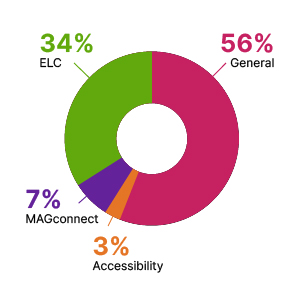
Funds Spent on DEAI-Centered Programs vs General Programs
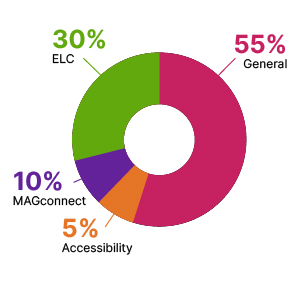
Marketing & Engagement Department
The Marketing & Engagement Department frequently works with community partners to collaborate in developing, executing, and leading a broad range of programs, such as our Celebration Series and other community-built programs, including our popular monthly DeTOURS℠. These programs bring the community to MAG to enjoy the museum in a number of ways that they might not consider to be “traditional” museum experiences.
The following data represents programs that occurred between January 2020 to March 2022.
Staff Time on DEAI-Centered Programs vs General Programs
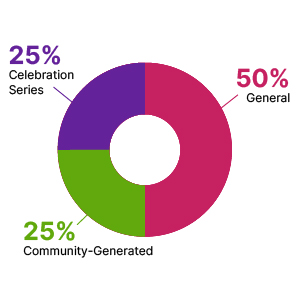
Funds Spent on DEAI-Centered Programs vs General Programs
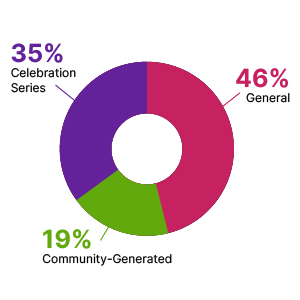
The following data shows artists featured in exhibitions presented over seven fiscal years, from July 1, 2014 to June 30, 2021. Identifying gender, race, and ethnicity for all artists has been done when known, to the best of the museum’s knowledge.
Races and ethnicities included under “Artists of Color”: American Indian/Alaskan Native, Black/African American, Asian, Hispanic, and Middle Eastern.
Percentage of Exhibited Artists by Gender
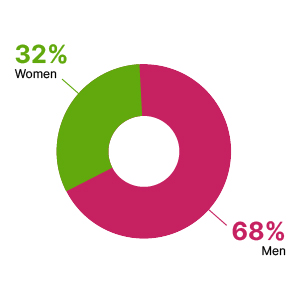
Percentage of Exhibited Artists by Race/Ethnicity
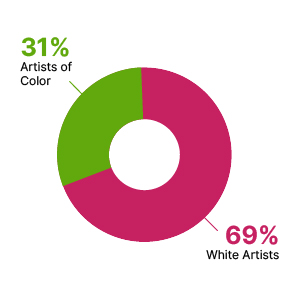
Percentage of Exhibitions Organized by MAG
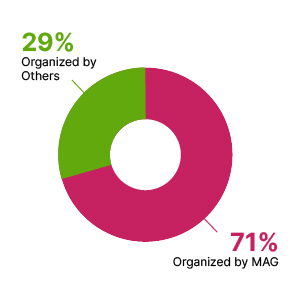
Percentage of Exhibitions Featuring Artists from Western New York
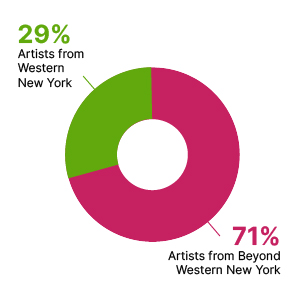
MAG currently features temporary and special exhibitions and installations in five galleries:
- The Forman Gallery is the first a guest encounters upon entering the Museum. It is an introductory space, where solo- and multiple-artist presentations often link to themes or subjects relevant throughout the permanent collection.
- Since 2016, the Hurlbut Gallery has been used for site-specific murals and installations by WNY artists. The purview of this gallery, however, is not limited to the work of WNY artists.
- The Media Arts Watch Gallery has been a dedicated space for the art of the moving image since 2015.
- The Docent Gallery is MAG’s largest temporary exhibition space, and features headline projects that help the museum reach the broadest possible audience.
- The Lockhart Gallery is generally reserved for showcasing works on paper from MAG’s permanent collection; however, it is also used to present smaller focus exhibitions and WNY artists.
The Memorial Art Gallery reviews exhibition proposals** and opportunities in a multistage process:
- MAG staff seek exhibition opportunities through a network of relationships among local, national, and international museum professionals, artists, gallerists, collectors, arts organizations, and independent curators. Proposals also come from MAG staff, members of the Board of Managers, and the general public.
- A compelling proposal is elevated to the Visioning Team for further consideration. The Visioning Team—comprising the Museum’s director and representatives from the Exhibition, Curatorial, and Academic Programs departments—meets monthly to review a wide variety of opportunities, including special exhibitions, potential acquisitions, permanent collection installations, and interpretation content and strategies. The Visioning Team vets a proposal’s artistic merit, scholarly integrity, and its potential for helping to advance MAG’s mission and to achieve its strategic initiatives in diversity, equity, accessibility, and inclusion (DEAI) as outlined in the Museum’s Strategic Plan (CLICK HERE to download the Plan).
- Proposals warranting further consideration are elevated to MAG’s senior leadership team. This team is responsible for all facets of MAG’s operations. Among many considerations, the senior team evaluates each proposal’s financial impact, the ability to raise funds to support the project, human resource and facility demands, and the proposed project’s potential to complement other aspects of MAG’s exhibition program, permanent collection installations, and its academic, community, and broad public programs, including community outreach.
- The final stage of the review process is to evaluate potential exhibitions and their opportunities for public engagement with input from focus groups and MAG stakeholders.
**MAG welcomes proposals for special exhibitions. To submit a proposal, please email: magexhibitions@mag.rochester.edu. The Museum is committed to reviewing all submissions. If MAG is interested in pursuing your proposal, a staff member will reach out regarding next steps. If you do not receive an inquiry for more information within 90 days, this is an indication that MAG has declined to pursue your proposal.
-
Dr. Vikram Dogra and the Dogra Art Foundation Champion South Asian Art at Memorial Art Gallery
The Memorial Art Gallery (MAG) is pleased to celebrate and expand access to South Asian art through innovative collaborations, commissions, and educational programming, with the generous support of Dr. Vikram Dogra and the Dogra Art Foundation. From commissioning a contemporary mural by an international artist to hosting thought-provoking lectures that examine the rich history and…
-
Black History Month Celebration Day to be held at the Memorial Art Gallery on Sunday, February 9
The Memorial Art Gallery invites visitors to its 24th Annual Black History Month Celebration Day, a free community event featuring live performances, art, dance, music, panel discussions, vendors, and more, on Sunday, February 9, from 12–5 pm. Enjoy live performances (African dance and drums, step teams, spoken word, contemporary dance, poetry, and live music with…
-
Annual Hispanic Heritage Celebration Day at MAG!
MAG invites you to Hispanic Heritage Celebration Day on Sunday, October 6, from 12-5 pm. Enjoy free museum admission, community and cultural tables, live dances and music, performances, and presentations around Hispanic countries. Our spotlight country this year is Peru! This year’s theme is “Pioneers of Change: Shaping the Future Together.” The day will include…
-
Free School Tours at MAG
The Memorial Art Gallery of the University of Rochester is excited to announce that for the 2024-2025 school year, School Tours for PreK-12th grades and Especially for Educators professional development workshops for teachers will be free for participants. This announcement, one of the first major initiatives under the new leadership at MAG, is important in…
-
New Acquisitions: Contemporary Indigenous Artists at MAG
With five recent acquisitions, MAG continues to move forward in its efforts to build a collection that better reflects our community. Sarah Jesse, the Mary W. and Donald R. Clark Director, stated, “We are so pleased that these artworks are now in MAG’s collection, where audiences can engage with their rich conceptual meaning and marvel…
-
Kwanzaa Celebration at MAG
Join the Memorial Art Gallery for a Kwanzaa Celebration on Thursday, December 28th from 5-8 pm. Enjoy make-it, take-it art, drumming and dancing, live music, and more. This is a free event, and registration is not required. Museum admission is not included. Timed ticket entry for INFINITY MIRRORED ROOM – LET’S SURVIVE FOREVER, 2017, will…
-
Memorial Art Gallery to Host Annual Hispanic Heritage Celebration Day
Join the Memorial Art Gallery for Hispanic Heritage Celebration Day on Sunday, October 1! Enjoy free museum admission, community and cultural tables, live dances and music, performances and presentations centered on this year’s spotlight country (Chile), storytelling, arts and crafts, and more. This year’s theme is Latinos Driving Prosperity, Power, and Progress in America | Latinos…
-
Memorial Art Gallery to Add Complimentary SNAP Membership Program to Current Community Outreach Initiatives
The Memorial Art Gallery of the University of Rochester (MAG) is pleased to announce participation in Museums for All. In 2019, MAG announced an addition to the Museum’s efforts to make exhibitions and programs accessible to a broad and diverse audience which offers free museum admission, for up to four people, with the presentation of…
-
Iconic Immersive Installation Coming to MAG
Globally celebrated artist, Yayoi Kusama, will be featured at the Memorial Art Gallery beginning in September. On loan from the Art Gallery of Ontario, one of her iconic immersive installations, INFINITY MIRRORED ROOM – LET’S SURVIVE FOREVER, 2017, will be presented to the Rochester community from September 14, 2023–May 5, 2024. INFINITY MIRRORED ROOM –…
-
Memorial Art Gallery to Host Annual Asian Pacific American Heritage Celebration Day
Sunday, May 7, from 12 to 5 pm, all ages are invited to the Memorial Art Gallery of the University of Rochester’s celebration of Asian Pacific American Month. Asian Pacific American Heritage Celebration Day will celebrate cultural heritage through community and cultural displays, live performances, a grand finale, and more. Plus, enjoy free museum admission!…

